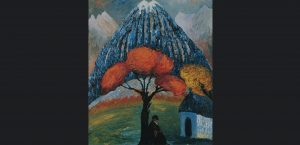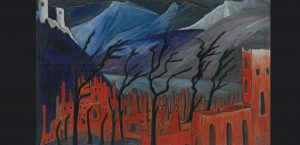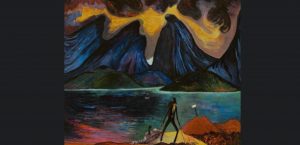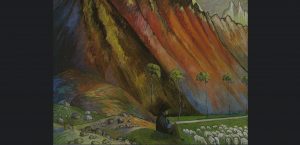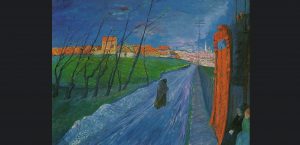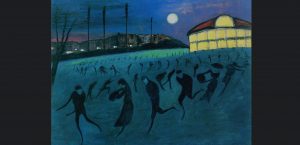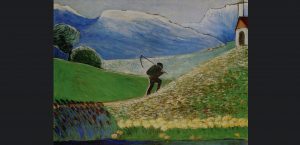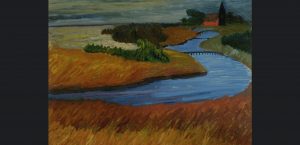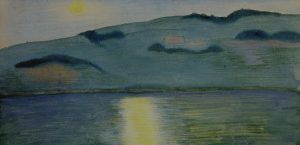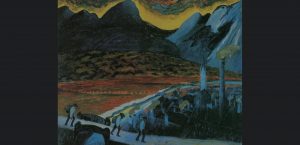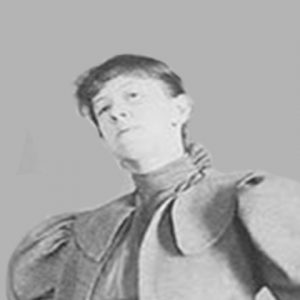Marianne von Werefkin was born on the 10th of September in Tula, into the family of a major commander and statesman Vladimir Werefkin and his wife Elizabeth, who was fond of portrait painting and icon painting. The family moved, following the appointments of the general, to Vitebsk, Vilna, Lublin and Moscow, until the father became the commandant of the Peter and Paul Fortress in St. Petersburg.
1860 - 1938
Marianne von Werefkin
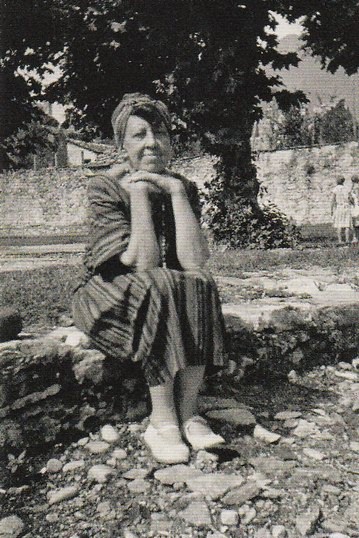
description
A Russian, German and Swiss artist, who made a great contribution to the Expressionist art movement in Germany and Switzerland.
She was the organizer of the New International Art Group of Munich, a member of the “Blue Rider” group. A big role was played by the society of artists “Great Bear” founded by her. The world-famous museum named after M. Werefkin works in Swiss Ascona, where there is a large collection of her paintings and works of her Expressionist colleagues, saved from being confiscated and destroyed after the Degenerative Exhibition of 1937.
Key ideas:
– Like many creators at the end of the 19th century, M. Werefkin looked for new forms of self-expression in arts. Later she recalled her participation in the exhibition of the Wanderers: “At that time they called me “Russian Rembrandt”, then Velasquez. In response to this brilliant criticism, I fell into despair — the world of Realism was as alien to me as the world of Romanticism.” In the period of the “vague idea of personal destiny,” Marianna and her friend Yavlensky go to Munich, one of the poles of attraction of Russian artists. The artist ceases to paint, plunging into the philosophical problems of the development of art. She realizes this interest at the Salon opened by her, where the most diverse artists come – in particular, Wassily Kandinsky, Paul Klee, Gabriela Munter. This period is an important stage of the theory.
– In 1905, she returned to painting in a completely new innovative style. In 1905, when Marianna Vladimirovna again takes brushes in her hand, absolutely new paintings are born; in them, the rhythms of the color planes are arranged in a smoothly curved perspective, which resembles works by Munch. Moreover, the contours outlined by the blue line evoke associations with the works of Matisse. However, the artist gives her plots a metaphysical meaning and makes them as expressive as possible. The technique changes radically: abandoning oil paints, she uses tempera and mascara, a slate pencil and pastel, combining them depending on the tasks.
– The experiments with the semi-abstract manipulation of the form and color are vividly illustrated by the “Self-portrait” of 1910. Dynamic and seemingly flowing brushstrokes in the style of Van Gogh, a clash of their bright confrontational shades (red-eyed look and green, blue background and clothing colors) in the style of Munch – all these Expressionist elements are visible. Here the artist is not an imitator, but an author of her own manner, which is demonstrated by a number of works – “Laundress” (1909), “Circus” (1910), etc.
1860
1872 - 1885
1885 - 1895
1896 - 1897
1905 - 1908
1909
1910 - 1913
1914 - 1917
1919 - 1922
1924 - 1928
1936 - 1937
1938
The birth of the artist
In Moscow, she took private lessons with Pryanishnikov at the school of painting, sculpture and architecture
Received an education at the Mariinsky Higher Women’s School of Vilna. In Moscow, she took private lessons with Pryanishnikov at the school of painting, sculpture and architecture. Painted still lifes under the guidance of Polenov.
In St. Petersburg, she met I. Repin
In St. Petersburg, she met I. Repin, who encouraged her talent and introduced her to Western European art. In 1891, visiting her studio workshop, she met A. Yavlensky, who became her idol and lover for almost 20 years. Undergoing treatment (while hunting, she shot her hand), she visited Dresden, Berlin and Munich, where she became interested in the painting of Western Europe. Participated in the 20th exhibition of the Ukrainian Academy of Art and Industry in 1892 (Repin called her “Russian Rembrandt”).
After the death of her father, she went with Yavlensky to Munich
After the death of her father, she went with Yavlensky to Munich, where the artists lived off the pension given to the commandant’s daughter. Made a trip around Europe in company with Azbe, Grabar and Kardovsky. The artist left painting, taking care of Yavlensky and fascinated by theories, for which she created “Pink Salon”, where artists came, including W. Kandinsky.
She took part in the Berlin Secession, at the St. Petersburg Salon
She continued to paint, met artist F. von Lenbach, the next year – F. von Stuck. In the summer, in company with Yavlensky, Kandinsky and G. Munter, she painted in the village of Murnau. She took part in the Berlin Secession, at the St. Petersburg Salon.
N.K.V.M.
Together with Kandinsky, Yavlensky and others, she created the “New Munich Art Association” (N.K.V.M.), participated in the First exhibition of the association at the Tannhauser Gallery (Munich). Got fascinated by Japanese art and woodcut.
Exhibited her works in Riga, at the gallery “Der Sturm”
Exhibited her works in Riga and St. Petersburg, visited Paris with Yavlensky, meeting with A. Matisse and others. Exhibited her paintings at the gallery “Der Sturm” (Berlin) with the group “Blue Rider” (Der Blaue Reiter). Left N.K.V.M., following W. Kandinsky, participated in exhibitions in Budapest, at the First Autumn Salon in Berlin.
Emigrated with A. Yavlensky to Switzerland
Emigrated with A. Yavlensky to Switzerland. Both participated in the Dresden exhibition, exhibited their works with the Blue Rider in Helsinki, Gothenburg and other European cities, helped A. Sakharov in the design and staging of the ballet (Lugano, Switzerland). In 1917, Werefkin and Yavlensky moved to Zurich, where they participated in Dadaists’ evenings at the Voltaire Cabaret. There they met artist Hans Arp, poet Hugo Ball and writer Hermann Hesse.
Finally settled in Ascona
Finally settled in Ascona, Ticino area, Switzerland. The complicated relationship with Yavlensky ended in 1921. The artist devoted herself entirely to creativity, starting with Ernst Kemper, a Swiss artist, to create a museum of modern art in the provincial town. She appealed to the fellow painters to provide for it one work at a time; now it is a world-famous museum bearing her name.
“Der Große Bär”
Founded the art group “Der Große Bär” (“The Great Bear”), which consisted of 7 members. Marianne met Ernst Alfred Aye; they were friends for all following years. Apart from the exhibitions of “The Great Bear”, her works were exhibited at the gallery Nierendorf in Berlin.
“A church”
Created her last painting “A church”. When new illnesses added to the recent heart disease, the artist’s friends Hagmanns took care of her. The paintings were included by the Nazis into the lists of “degenerative art”; however, most of the works were saved by her friends.
The death of Marianne von Werefkin
She died on the 6th of February and was buried in Ascona according to Orthodox rites of a special priest who came from Milan. In the same year, retrospective exhibitions of the artist were held in Zurich and Bern. She bequeathed her works to her friend Santo from Berlin. However, he had to abandon the inheritance: being worried of confiscation, he gave it to benefactors who lived in the German part of Switzerland. There the Marianna Vladimirovna Verevkina Foundation was subsequently created to preserve the heritage of the talented Expressionist.
Marianne von Werefkin
On Artist
flow
Постимпрессионизм
friends
Ferdinand Hodler
Wassily Kandinsky
Jean Arp
Gabriele Munter
Kuno Amiet
Ernst Alfred Aye
Hermann Hesse
Alexey von Yavlensky
Igor Grabar
Anton Azhbe
Dmitry Kardovsky
Franz von Lenbach
Franz von Stuck
Alexander Kanoldt
artists
Vincent van Gogh
Paul Cezanne
Andre Derain
Paul Gauguin
Henri Matisse
Illarion Pryanishnikov
Vasily Polenov
Ilya Repin
By Artist
flow
Экспрессионизм
friends
Otto Naymeier
Karl Schmidt-Rothluf
Christian Rolfs
artists
Walter Helbig
Ernst Frick
Gordon Mallet McCooch
Albert Kohler
Otto van Rice
Richard Sevald


